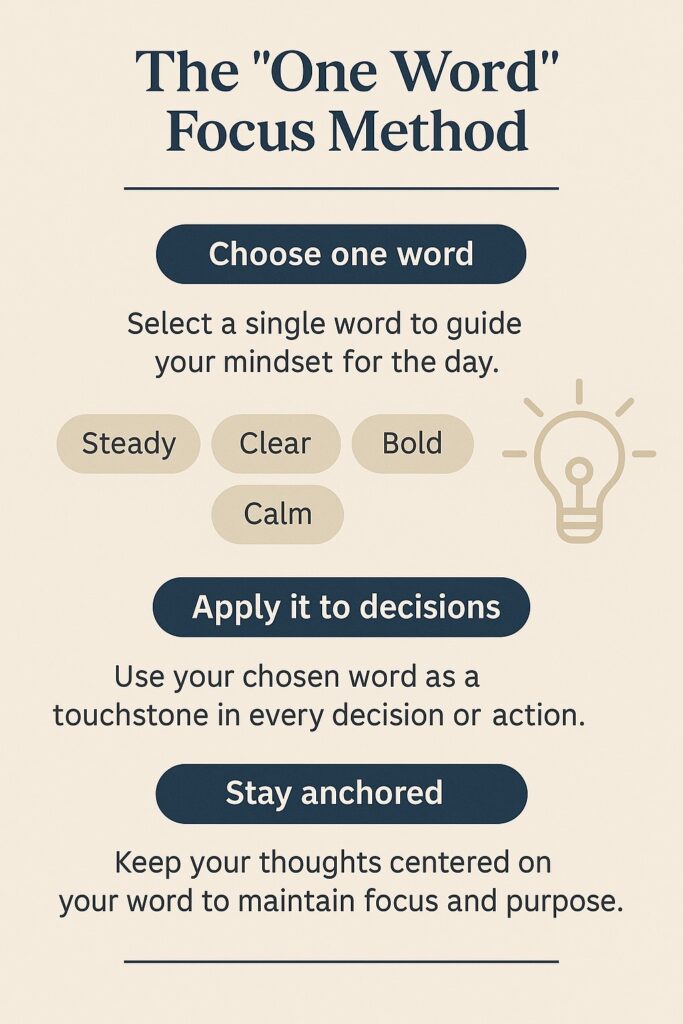The One-Word Focus Method: Anchoring Your Mindset Daily

The one-word focus method is a mindset tool that simplifies your day by grounding your attention in one guiding word. Instead of attempting to adhere to multiple goals or resolutions, you focus on a single word to change your habits. In a fast-paced world filled with endless demands, distractions, and decisions, it is all too easy to feel scattered or to stay focused.
Many people wake up already overwhelmed, juggling a long list of tasks while trying to maintain clarity of thought and balance in daily life.
The one-word focus method is surprisingly powerful in its simplicity. By committing to one chosen word, you create a filter for your decisions and actions throughout the day. Whether that word is “steady”, “clear”, “bold”, or “calm”, it gives you something consistent to return to when life feels chaotic. The practice works not because it erases your problems, but because it anchors your thinking, helping you make decisions with intention rather than impulse.
What Is the One-Word Focus Method?
The one-word focus method is built on the idea of micro-intention settings. Instead of trying to manage an overwhelming set of affirmations or goals, you distil your focus into one single concept. This word is more than just a reminder but becomes your mindset lens for the day. It frames how you respond to challenges, how you communicate with others, and how you direct your energy.
Imagine waking up and choosing the word “steady.” Throughout your day, whenever stress or pressure arises, you remind yourself of that word. Instead of rushing through tasks, you slow down and move with intention.
Or, if you choose the word “bold”, you carry it into your conversations, your choices, and your actions, encouraging yourself to step into opportunities you might otherwise avoid. Each word offers a kind of compass, helping you navigate the day in alignment with your values.
Such simplicity is why the method resonates with so many people. It strips away complication and gives you a clear sense of direction.
Why the One-Word Focus Method Works
What makes this practice so effective is the psychological principle of focus. Our brains are easily distracted, especially in a digital age where notifications, emails, and social media constantly compete for attention. A single focus word can give your brain a point of return, namely a mental anchor that quiets unnecessary noise.
Micro-intention setting also works because it trains the mind to make small, consistent adjustments rather than making unsustainable changes. While ambitious goals can feel overwhelming, a single word feels achievable. It makes you more accountable, reminding you of the mindset you want to embody without creating pressure or guilt.
Research on mindfulness and positive psychology supports this approach. Anchoring thoughts to a simple intention reduces stress and improves decision-making. It also nurtures self-awareness, because each time you recall your word, you pause and check in with yourself before reacting. Over time, these pauses accumulate into a calmer, more deliberate way of living.
How to Practise the One-Word Focus Method
Putting the one-word focus method into practice is simple but requires consistency. Each morning, take a moment of quiet reflection. Ask yourself, “What do I need most today?” The answer will help guide your word. If you are dealing with a packed schedule, your word might be “steady”. If you need courage for a presentation, it could be “bold”. If you want clarity in your decision-making, perhaps your word is “clear”.
Write your word down after you’ve decided on it. While some people prefer journaling, others display their word on a sticky note by their desk or set it as their phone wallpaper. Seeing the word regularly reinforces the intention. Throughout the day, pause before decisions or challenges and ask, “Does this align with my word?” This simple habit reconnects you to your intention, ensuring that your mindset shapes your actions rather than the other way around.
In the evening, take a few minutes to reflect. Ask yourself how the word influenced your day. Did it help you stay calm in moments of frustration? Did it encourage you to be braver in your conversations? This reflection helps solidify the practice and prepares you for the next day.
Examples of the One-Word Focus Method
Consider a manager heading into a day of back-to-back meetings who chooses the word “calm”. During tense discussions, the single word reminds them to respond thoughtfully instead of reacting emotionally.
Consider a student preparing for an exam who has chosen the word “clear.” Each time they feel anxious, they return to their words, helping them focus on their clarity of thought rather than spiralling into stress.
Even in small, everyday situations, the method makes a difference. Someone might choose the word “kind” before visiting family, using it to guide their words and actions during interactions. Another person might choose “grateful” on a difficult day, reminding themselves to notice small joys rather than dwell on frustrations.
These examples show that the method is flexible and adaptable. The power of the word lies not in its complexity but in its ability to ground you in the present moment.
Benefits of the One-Word Focus Method
Over time, the benefits of this practice become clear. By focusing on one word, you reduce mental clutter and simplify your priorities. This clarity strengthens mindfulness, helping you align your thoughts and actions with greater consistency. Decision-making also becomes easier because your word acts as a filter. If your word is “steady”, for instance, you are more likely to decline unnecessary commitments that would disrupt your balance.
The method also builds confidence. Each day you say a single word, you see evidence of growth. You notice yourself acting more intentionally, handling stress with more calm, or approaching opportunities with more courage. These small daily victories accumulate, changing your mindset in lasting ways.
Another benefit is emotional resilience, which strengthens your ability to handle difficult situations. Your chosen word becomes a steadying presence when life throws challenges your way.
Why Micro-Intentions Matter
One of the most powerful aspects of this method is its reliance on micro-intentions. Unlike broad goals that often remain abstract, a single word provides you something tangible. Micro-intentions are achievable because they encourage small, daily alignment rather than large-scale changes. This feature makes the practice sustainable and practical, even for those with busy lives.
Micro-intentions also highlight the importance of presence. When you focus on one word, you bring your attention back to the current moment. This mindfulness is key to reducing stress and increasing satisfaction, as it shifts your energy away from regret about the past or anxiety about the future.
The one-word focus method may seem simple, but its impact can be profound. With a single mindset word each day, you practise micro-intention setting, anchoring your thoughts and guiding your decisions with purpose. Whether you choose “steady”, “clear”, “bold”, or any other word that resonates with you, this small act creates a framework for mindful living.
Instead of being pulled in every direction by distractions and demands, you give yourself a compass that points you toward clarity and meaning.
Over time, these daily words influence not only how you move through the world but also how you see yourself. If you are ready to shift your mindset and bring more purpose into your day, start tomorrow with just one word and let it guide you forward.

Continue Reading
- Understanding Self-Esteem: Meaning, Examples, Types, and How to Raise It
- How to Build Authentic Confidence Without Faking It
- The One-Word Focus Method: Anchoring Your Mindset Daily
- Mindset for Ageing: How to Change Your View of Growing Older
- Breaking Free from the Guilt Mindset: How to Let Go and Heal
Leave a Comment